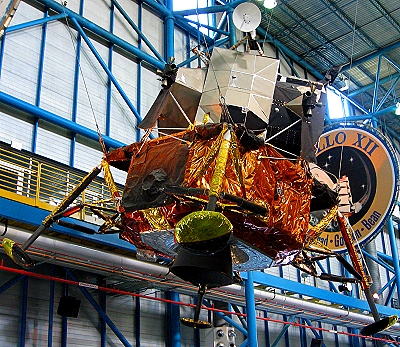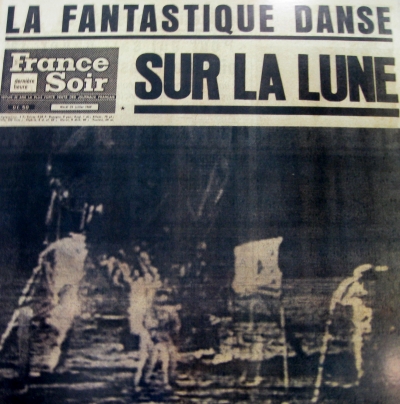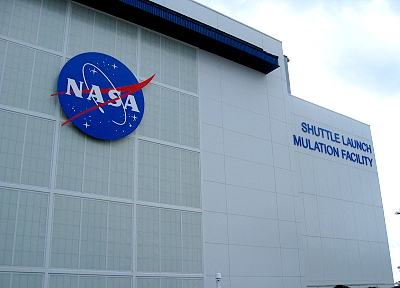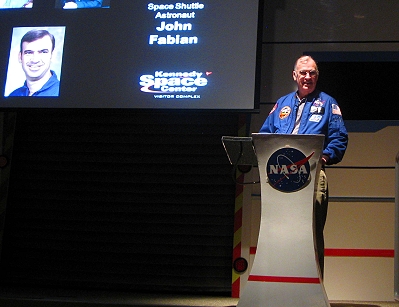
For many of us the moon landing in July 1969 holds a prominent place in our memories. The scratchy black & white images are burned indelibly into our minds.
We were children of The Space Age. We drank Tang, ate Space Food Sticks, watched The Jetsons and dreamed of Jeannie (yes, gentlemen, there were astronauts in I Dream of Jeannie).

This made our visit to The John F. Kennedy Space Center on Florida’s Space Coast as much a trip down memory lane as an exploration of current space exploration.
In fact, American manned space flight really has become just a memory, since last year, forty-two years after we first set foot on the moon, the final manned mission left from here.

But that disapointing lack of activity didn’t diminish the story of perhaps the most epic journey in human history that departed from this place back in the summer of ’69.
It is that project that still dominates this place. When we rode the bus out to the launch site viewing area, it was pretty easy to imagine an Apollo rocket sitting on the empty pad 39-A.

From there we were taken past the iconic Vehicle Assembly building, one of the largest structures in the world – so huge it looks surreal – to The Apollo / Saturn V Center where the massive missile that took man to the moon is on display.
The Saturn V is the largest rocket ever made, and in this exhibit we got to look one over from ground level. The real thing, this very rocket was ready to go into space as Apollo 19 when the program was cancelled.
Now it has been separated into its various sections and laid out on its side for up close viewing.

Starting at the enormous F-1 launch engines, we worked our way past the next two stages, that would have lifted the mission into Earth orbit, then finished at the top where the command, service and lunar modules are housed.

To get an even better look at these “brains” of the rocket we walked across for a peek at a command module that had actually been in outerspace on Apollo 14.
We knew from history that the quarters were tight, but to see it in person made the tinyness really hit home.

An actual lunar module, that would have landed on the moon had the mission proceeded, was also on display, as was a lunar rover.
It was very cool to see the giant bug-like LM and funny little dune buggy-esque rover up close, but the highlight of our excursion through The Saturn V Center had to be the opportunity to chat with a real live rocket scientist.
Retired NASA engineer Roy Whitson was ready, willing and able to answer any questions that we (or anybody else for that matter) could throw at him. Incredibly personable and knowledgeable, Mr. Whitson happily relayed first hand accounts of some of the innermost workings of the space program, all the way from the early days in the 60s to the present.

Mr. Whitson was there through it all, designing systems for the Gemini, Apollo and finally the Shuttle programs.
He knew all of the astronauts personally, and referred to these pioneer explorers in the most familiar, nonchalant manner of a trusted colleague and friend.

Our favorite story had to be how Neil Armstrong, the first man on the moon, nearly botched the lunar landing by overtaxing the computers on the landing module.
The technology of the day was so primitive by today’s standards, that handling two tasks simultaneously was causing the on-board flight computer to shut down. We literally carry around more computing power in our pockets these days than was available for man’s first landing on a celestial body in space.
It was incredibly difficult to tear ourselves away from Mr. Whitson’s engaging insights and recollect-ions, but we really had to move on if we were going to manage to see everything before closing time.

From the Apollo exhibit we made our way through the Rocket Garden, a forest of launch vehicles from the Mercury, Gemini and Apollo programs.
Surrounded by the behemouth rockets we were again struck by how huge a vehicle is needed to launch a tiny capsule out of the earth’s gravety. By weight only about one percent of the craft returns. Scale models of some capsules allowed us to get a true feel for just how cramped things were.

After the garden we mosied on to the Shuttle Experience. Here we got to go inside a full scale mockup of the spacecraft, but the highlight was a simulated blast off in a shuttle. We were definitely sceptical, the possibility for extreme cheezyness seemed high. Boy were we wrong!
This “ride” was executed to perfection, it would seem that NASA knows a thing or two about simulators. From the fake G-forces at liftoff, to the feeling of weightlessness as we entered space, every sensation felt completely real. So much so that we turned around, got right back in line and did it again.
The second time we tried to pay closer attention to how the combination of sight, sound and motion fooled our senses, but even with knowing what was coming, it still felt real. Pretty amazing and probably the closest we’ll ever get to going into space.

After our second shuttle mission we felt like we were ready to see a real astronaut. Why not, we practically were old hands ourselves now.
Colonel John Fabian, veteran of Shuttle missions #7 and #51 was the day’s guest speaker at The Astronaut Encounter. He spoke for a few minutes before opening the floor to questions, which included the classic, “How do you go to the bathroom in space?”
No doubt every spaceman has fielded that one many more times than they would ever care to, but he handled it with an informative mix of facts and humour. Obviously not his first time.
WATCH (it’s GREAT!):
After the question and answer session we decided to take one more trip into space. Back to the Shuttle Experience! Still felt real. We found out that the simulator is nearly identical to the ones used to train the astronauts, and even this tourist version set back NASA sixty million dollars. Wow, it should feel real for that kind of dough.
On our way out of the the visitor area we ran into Colonel Fabian as he was leaving too. He was great, very gracious and happy to talk to a couple old space-aged kids, and took the time for a couple more questions in a one-on-one situation.
In our chat we learned that he was in the very first group of trainees chosen for The Shuttle program. He also told us that the simulator ride really does feel like the real thing, especially “the first three seconds.” There we had it, straight from the astronaut’s mouth, wow, what a day!

There was one last thing we had to check out before we could feel like we had the full 1960s astronaut experience, the town of Cocoa Beach, home of Major Nelson, Major Healey and of course, Jeannie. The two bumbling TV spacemen didn’t rate any acknowledgement from the town, but the city did have the wisdom, refinement, class, culture, enlightenment, tastefulness, dignity and grace to name a street after Jeannie. Good to see they have their priorities straight.
David & Veronica, GypsyNester.com



Very cool that you could talk with a retired NASA engineer. And the Shuttle Experience sounds like quite the ride! Did you guys feel sick at all?
It was very cool! We are both lucky that motion never bothers us.
Haven’t been to Florida but if we do go then this would definitely be on the list to visit! Love that you get to see so many of the inner-workings of NASA. And that they have people on hand to chat with you!
It’s very cool, and the personal contact made it even more so.
I’m with Sophie – heading for Florida at our first opportunity. My dad used to wake us up early to watch the take offs. “C’mon T minus 10 minutes, get up!” And before he passed away he took two of his formerly kids’ bedrooms, made it his ‘media room’ and set up computers to track all kinds of stuff. He knew exactly when the MIR space station was directly overhead. Thanks for sharing this bit of space history with us!
Very cool! The space centre is top of my list for a visit to Florida 🙂
Oops. Thanks Denise, good catch. The final shuttle mission ended on July 21 so you are right. We’ll fix the article.
Thanks again – we appreciate you!
Hi guys!
Thanks for yet another great story. I hate to quibble, but your dates are confusing me: We set foot on the moon for the first time on 20 July, 1969, and the final shuttle mission launched on 8 July last year according to records. So that’s not 42 years and one day. Am I misapprehending your meaning?
Keep it up! Keep on doing my traveling for me!